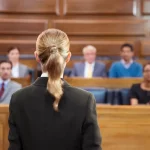The prospect of a jury trial often raises an important question: “Why does a case even go to trial? Don’t cases get dismissed if the person is not guilty?” This is a fair and logical inquiry, and the answer lies within the complexities of our justice system. Jury trials are not just for determining guilt or innocence; they are a safeguard of fairness and a critical component of due process. To truly understand why cases go to jury trial, we need to explore the process that takes a case from the alleged crime to courtroom and the protections in place to prevent the innocent from being wrongly prosecuted or convicted.
Why Aren’t Cases Dismissed if Someone Is Not Guilty?
Let’s start by addressing the elephant in the room: why doesn’t the court simply dismiss a case if the person is innocent? The answer lies in a fundamental principle of justice, the presumption of innocence. In the U.S. legal system, everyone is presumed innocent until proven guilty. This means determining innocence or guilt requires a thorough evaluation of evidence, and that process often takes place in a courtroom before a jury.
While it’s true that cases can be dismissed before trial if there’s insufficient evidence, it’s not the judge’s role to decide guilt or innocence. That responsibility lies with the jury. Judges may dismiss cases for procedural reasons, such as a lack of probable cause or inadmissible evidence, but most cases that proceed to trial do so because there is enough evidence to warrant a jury’s consideration.
In America, the power to bring charges against a person is vested in the prosecutor for the jurisdiction (District Attorney, City Attorney, United States Attorney, etc.), and they are ethically obligated to dismiss any case or charges that they do not believe can be proven beyond a reasonable doubt to a jury. Unfortunately, some prosecutors fail to look at a case through this prism, and an innocent person may be forced to proceed to a jury trial.
Now, let’s dive deeper into the process that brings a case to trial and the safeguards designed to protect the innocent.
The Journey to a Jury Trial: Step by Step
The path from alleged crime to jury trial involves several critical stages. Each step is designed to ensure fairness and accuracy while protecting the rights of the accused.
1. Crime Committed
It all begins with the alleged commission of a crime. Whether it’s a theft, assault, or another offense, conduct that may be a crime sets the wheels of the justice system in motion. Law enforcement officials investigate the incident to gather evidence, identify suspects, and build a case.
2. Arrest
If there is sufficient evidence to believe someone committed the crime, law enforcement may make an arrest. However, arrests aren’t made lightly. Police must have probable cause – a reasonable belief based on facts and circumstances – to justify taking someone into custody. If the crime is a misdemeanor (where your sentence can be up to a year in the County Jail), the officer would personally have to see the accused commit the crime to make the arrest. On a felony matter (a crime where the sentence can include over a year in the state prison), the officer may arrest a person if there is sufficient probable cause to believe they committed the crime.
3. Charges Filed
Once an arrest is made, the case is handed over to the prosecutor’s office. Prosecutors review the evidence collected during the investigation and decide whether there is sufficient evidence to prove a charge beyond a reasonable doubt to a jury. This is a much higher level of proof than the probable cause required to arrest an individual. The prosecutor can file different charges than the person was arrested for, if they feel the evidence warrants those charges. If the prosecutor does not feel that the evidence is sufficient to file charges, they may decline to file charges (reject the case) or send the case back to the arresting agency with instructions to address certain issues with the evidence necessary to prosecute the person for a particular charge. Some prosecutors may decide to file charges with the hope that the missing elements will be discovered prior to a jury trial.
The prosecutor must prosecute a case in a timely manner, which means the charges must be filed before the statute of limitations has passed.
This step is a critical safeguard against wrongful prosecution. Prosecutors have an ethical duty to pursue charges only when there is enough evidence to reasonably believe the accused is guilty beyond a reasonable doubt. In some cases, the police and prosecutors know who committed the crime, but there is not enough admissible evidence to file charges.
4. Preliminary Hearing or Grand Jury
In many felony cases, a preliminary hearing or grand jury review is conducted to determine whether there’s enough evidence to proceed to trial.
- Preliminary Hearing: A judge evaluates the evidence presented by the prosecution and decides whether there is probable cause to believe that the accused has committed the felony charged. The defense can challenge the sufficiency of evidence and argue for dismissal but generally will not present a defense.
If the judge does not find there was sufficient evidence presented, they will not hold the defendant to answer on the charge or charges. Any charges that the judge determines had enough evidence would then proceed to a Jury Trial.
- Grand Jury: In some jurisdictions, a grand jury reviews the evidence and decides whether to issue an indictment (formal charges). The grand jury will evaluate the evidence presented by the prosecutor, but the accused does not have the right to a defense attorney present to challenge the evidence presented.
5. Arraignment
If charges are filed, the defendant appears in court for arraignment. During this hearing, the charges are formally read, and the defendant enters a plea (guilty, not guilty, or no contest). If the plea is “not guilty,” the case moves forward to trial. Unless the charge alleged is not a legal charge, the arraignment is not an opportunity to have the case dismissed.
6. Pretrial Motions
Before the trial begins, both sides may file motions to shape how the trial will proceed. For example, the defense might file a motion to suppress evidence obtained unlawfully or to dismiss the case altogether. These motions play a key role in ensuring a fair trial.
- Speedy Trial Motion: The defendant may file a motion stating that the case was not filed within the “statute of limitations.” If the court finds that the statute of limitations passed before the defendant was brought to court, the case may be dismissed and never be brought again.
- Motion to suppress evidence: The defendant may file a motion to be heard prior to the jury trial, asking the court to suppress evidence that was obtained in violation of the defendant’s constitutional rights (such as an illegal search or seizure). If the motion is granted, then the evidence illegally obtained and any evidence obtained as a result of that evidence will be excluded from the case. This may result in the case being dismissed.
- Pretrial motions regarding the trial: Prior to picking a jury, the Court will have a hearing on what evidence is going to be presented during the trial. These hearings will limit the presentation of some evidence, if it is too prejudicial to one of the sides compared to its probative value. The court may limit who can be in the courtroom during different parts of the trial, or what evidence is allowed. These motions are designed to narrow down what is presented to the jury to make sure the trial is fair, and the verdict is just. For example, you would not want the jury to know that the defendant was convicted of murder, if he is being charged with a DUI, because the murder conviction may cause a jury to find him guilty of the DUI, even if the evidence was not sufficient to prove the case.
7. Trial Preparation
If the case survives pretrial motions, both the prosecution and defense prepare for trial. This involves gathering witnesses, analyzing evidence, and crafting arguments. At this stage, plea bargains may also be negotiated, potentially avoiding a trial altogether.
Discovery: in preparation for a Jury Trial, each side is required to provide the evidence they expect to present during the trial to the other side (including witness lists, physical evidence, and exhibits). You are not required to provide evidence that you intend to use to impeach a witness should they testify. The goal is for both sides to understand what the evidence is, so they can address it, or they may decide that the evidence is so substantial, the accused would be better served by resolving the case with a plea bargain.
Plea bargain: This is an agreement between the prosecutor and the defendant, and approved by the court, where the defendant will enter a plea of guilty or no contest to a charge or charges, in exchange for the dismissal of some charges, or for a particular agreed-upon sentence. At this stage of the case, the prosecutor will usually offer something better than the defendant would expect to receive if they were found guilty at trial.
8. Jury Trial
Finally, the case reaches the courtroom. A jury is selected by both sides of the case, where jurors who have a bias for or against one of the sides are eliminated and the ultimate jury is expected to fairly evaluate the evidence and follow the law to reach a verdict. Once the jury is selected, evidence is presented, witnesses testify, and arguments are made. The jury deliberates and reaches a verdict based on the evidence and instructions from the judge. To be found guilty all twelve jurors must agree that the evidence presented proves you guilty of the charge beyond a reasonable doubt. If the prosecution does not prove the accused guilty beyond a reasonable doubt, then the jury must find the accused not guilty.
Protections Against Wrongful Accusations
The legal system is far from perfect, but it includes numerous safeguards to prevent innocent individuals from being wrongly charged or convicted. Here are some of the key protections:
1. Presumption of Innocence
Every defendant is presumed innocent until proven guilty. This fundamental principle ensures that the burden of proof lies with the prosecution, not the accused. This presumption must be shared by the jurors prior to the presentation of evidence. It is not uncommon for a potential juror to enter the courtroom with the question, “I wonder what he did?” rather than, “I wonder if he is wrongfully accused?”
2. Probable Cause Requirement
Before an arrest or indictment, law enforcement and prosecutors must establish probable cause. This threshold should prevent baseless accusations from advancing. If the prosecutor looks at evidence critically, then it is likely that false charges will not be filed. Some prosecutors are less discerning and file any cases brought to them by the police, which may result in the innocent being charged.
3. The Right to Remain Silent
Everyone in America has the Constitutional Right to remain silent. This means that the police cannot force you to give them information about the allegations and your possible role in it. Many ignore this right and attempt to “talk their way out of a crime.” But that is rarely successful, so if you are ever told you have the right to have an attorney before speaking to the police, get an attorney before speaking to the police. A jury trial may be the best place for you to tell your story.
4. Right to Counsel
Defendants have the right to legal representation. Defense attorneys play a critical role in challenging evidence, cross-examining witnesses, and ensuring their clients receive a fair trial. Without defense attorneys the prosecutor would be putting people in jail with no accountability.
5. Right to a Speedy Trial
The Constitution guarantees the right to a speedy trial, preventing defendants from languishing in legal limbo for extended periods. This right generally calls for a trial to begin within a month or two of arrest. However, a defendant may need more time in order to be better prepared for a trial, so they may waive their right to a speedy trial.
6. Evidence Standards
For a conviction, the prosecution must prove guilt beyond a reasonable doubt – the highest standard of proof in the legal system. The court will instruct a jury that if the prosecutor is attempting to prove a charge was committed, they must prove each element of the charge beyond a reasonable doubt, and if they fail to prove one of the elements, then the Jury MUST find the defendant not guilty. This rigorous standard, and the right to a jury, is our system’s safeguard against wrongful convictions.
7. Appeal Process
If a defendant believes they were wrongfully convicted, they have the right to appeal the verdict. Appellate courts review the trial record for legal errors that may have affected the outcome, as well as mistakes made in the admission or prevention of evidence being presented, the instructions to the jury, or the actions of the Court, or the attorneys.
Why Does a Jury Trial Matter?
Jury trials are a critical component of justice because they ensure that guilt or innocence is determined not by a single authority but by a group of impartial citizens. This process brings community values into the courtroom and acts as a check on government power.
When a case goes to trial, it’s because the facts are in dispute, and a jury’s perspective is needed to evaluate the evidence. Trials are not about rubber-stamping guilt; they’re about ensuring fairness, accountability, and the opportunity for all sides to be heard. It is critical that we have people who live in the community listen to the evidence presented from an unbiased position, and determine whether guilt has been proven beyond a reasonable doubt. Sometimes, a jury is the only group that is willing to listen to your side of the case.
The Importance of Due Process
So, why does a case go to jury trial? Because our justice system is designed to punish those guilty of crimes, and to free those who are not guilty of crimes. In many cases, the system does not screen out those who are innocent, and the defendant’s only protection from a wrongful conviction is an independent jury who will neutrally evaluate the evidence and determine whether the elements have been proven beyond a reasonable doubt. Yes, the accused is guaranteed their day in court, but a jury trial may be the only opportunity the defendant has to tell their side of the story to someone who will listen. Sometimes a defendant is innocent, and the police and prosecutor will not listen–but a jury will. From the initial investigation to the final verdict, the system includes multiple checks and balances to protect the innocent and ensure justice is served.
By understanding the journey, a case takes and the safeguards in place, we can appreciate the vital role jury trials play in upholding the rule of law and safeguarding individual rights.
The Author: Michael T. Meehan
Michael T. Meehan, founder of The Meehan Law Firm, brings over 25 years of exceptional criminal defense experience. A former sheriff and prosecutor, he is renowned for his tenacious pursuit of justice in even the most complex cases. Michael’s unwavering dedication to his clients has earned him a reputation as a trusted and skilled advocate. Outside the courtroom, he is a devoted father to quadruplets, balancing family life with his passion for delivering justice and protecting his clients’ rights.






